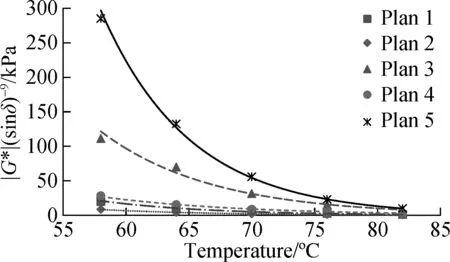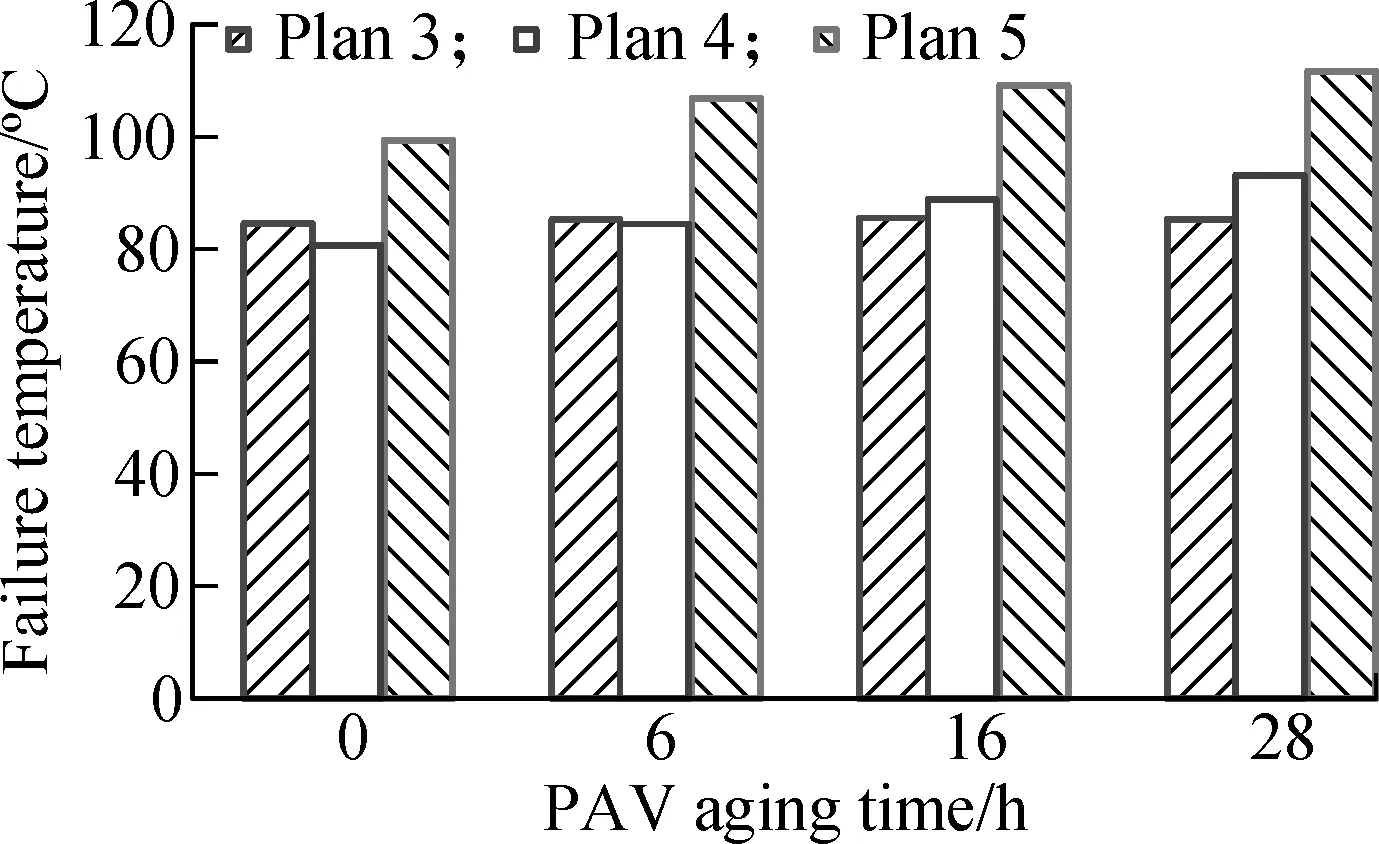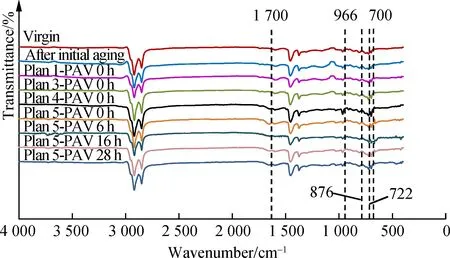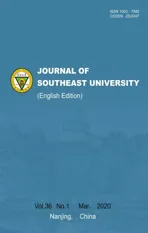Evaluation of rutting and low-temperature cracking resistancesof warm-mix recycled asphalt bindersunder the secondary aging condition
2020-05-10LiQiangSunGuangxuLuoSangZhouZhouMengYuanpeng
Li Qiang Sun Guangxu Luo Sang Zhou Zhou Meng Yuanpeng
(1College of Civil Engineering, Nanjing Forestry University, Nanjing 210037, China)(2National-Provincial Joint Engineering Research Center of Electromechanical Product Packaging,Nanjing Forestry University, Nanjing 210037, China)(3School of Transportation, Southeast University, Nanjing 211189, China)
Abstract:The rutting and low-temperature resistances of warm-mix recycled asphalt binders under the secondary aging condition were measured by the dynamic shear rheometer test and bending beam rheometer test. Effects of different types of warm-mix asphalt (WMA) technologies and additives were evaluated. Aging and improvement mechanisms were investigated by the Fourier transform infrared spectroscopy test. It is found that recycled binders after the secondary aging are more resistant to rutting and less resistant to low-temperature cracking. The two warm-mix asphalt technologies have opposite effects. Using the Sasobit WMA significantly improves the rutting resistance and reduces the low temperature resistance for the recycled binders due to its morphological change at different temperatures. The rutting factor values of recycled asphalt binders with the Sasobit additive increase by 4.6 to 5.6 times. However, using the Evotherm WMA causes the deterioration of the rutting resistance due to the structural lubrication effect. The rutting factor values of recycled asphalt binders with the Evotherm additive show the reduction of 52% to 62%. It is recommended to add the styrene butadiene rubber latex or crumb rubber powder into the warm-mix recycled asphalt binders to simultaneously improve the rutting and low-temperature cracking resistances.
Key words:pavement engineering; warm-mix recycled asphalt binder; low-temperature cracking; rutting; secondary aging; Fourier transform infrared spectroscopy
The warm-mix asphalt (WMA) technology is used to effectively reduce construction temperatures by 20 to 30 ℃ for reclaimed asphalt pavements (RAP). It delays the short-term aging behavior of recycled asphalt binders and reduces the emission of pollutants during the construction process at high temperatures[1]. It is well known that asphalt binder aging is an irreversible process and it can significantly affect the pavement performance at both high and low temperatures[2]. The loss of volatiles and light chemical components during the aging process leads to the binder stiffening. The decrease of light chemical components and the increase of asphaltene content weaken the stress release ability of binders in low temperatures[3]. As a result, low-temperature cracking is easily caused[4]. Aging reduces the binder strain generated under the stress and improves the rutting resistance[5].
Using the WMA technology can cause an increase in the RAP content. Xiao et al.[6]reported that although increasing the RAP content improved the rutting resistance of asphalt binders but reduced the cracking resistance, the WMA additive could offset these properties. Sun et al.[7]evaluated the effects of different WMA additives on recycled asphalt binders with a high RAP content (30% to 70%). It was found that adding the WMA additive significantly lowered the rutting resistance and adding another one slightly improved it. However, adverse trends were found in terms of the low-temperature cracking resistance[8]. Kim et al.[9]also confirmed that the WMA additive type had a significant effect on the high and low temperature performance of the recycled binders.
The aging behavior of warm-mix recycled asphalt materials can be divided into two stages. The virgin binder experiences the initial aging process during the first newly constructed pavement service period. The secondary aging occurs during the recycled pavement service period[10]. Much research only focused on the pavement performance of the virgin binders during the initial pavement service period. However, the aging behavior of recycled binders during the secondary pavement service period is more complex. It is affected by the WMA technologies, rejuvenator additives, other additives, and the properties of the virgin binders[11]. The main purpose of this study is to evaluate the rutting and low-temperature cracking resistances of warm-mix recycled asphalt binders under the secondary aging condition. Effects of recycling plans and aging levels were investigated by the conventional physical properties test, dynamic shear rheometer (DSR) test, and bending beam rheometer (BBR) test. Aging and improvement mechanisms of the recycled binders were finally clarified by the Fourier transform infrared spectroscopy (FT-IR) test.
1 Experimental Plan
1.1 Materials
Five recycling plans are designed as shown in Tab.1. The styrene butadiene styrene (SBS) modified asphalt binder shown in Tab.2 was selected as the virgin binder for the laboratory aging simulation. The rejuvenator additive was used to recover the rheological properties of aged binders. Two types of WMA additives commonly used were selected to reduce the construction temperature and alleviate the aging effect. One was the surfactant-based Evotherm WMA additive. The other was the organic Sasobit WMA additive. Two types of other additives were also used to improve the pavement performance of the recycled binders. One is the styrene butadiene rubber (SBR) latex. The other is the crumb rubber powder (CRP). All additives used in the study are shown in Fig.1. Physical and chemical properties of various types of additives are provided in Tab.2. The optimum content values of various additives recommended from the existing study are used[10,12].

Tab.1 Recycling plans

Tab.2 Physical properties of asphalt binders

Fig.1 Appearance of additives
The aged SBS modified asphalt binder was firstly heated to 175 ℃ to reach the flow state. The WMA additive, if necessary, was added to the melted binder and stirred at the temperature of 140 ℃ for 10 min. Then, the rejuvenator additive was subsequently added and stirred for 10 min at the temperature of 170 ℃ for plan 1 and 140 ℃ for plans 2 to 5, respectively. The SBR latex or CRP, if necessary, was finally added and stirred for 30 min at the temperature of 140 ℃ to ensure uniformity. Five types of different recycled asphalt binders were completely fabricated according to the recycling plans.
1.2 Laboratory aging simulation procedure
Warm-mix recycled asphalt binders under different aging levels were produced by a two-stage simulation method[12]. At the initial stage, virgin binders were aged in turn by the rolling thin film oven test (RTFOT) at the temperature of 163 ℃ for 85 min and by the pressure aging vessel (PAV) at the temperature of 100 ℃ and the pressure of 2.1 MPa for 20 h, which simulated the first service period of 12 years before recycling. After recycling, recycled binders were aged again by RTFOT and PAV, following the similar procedure. The PAV aging durations of 0, 6, 16 and 28 h at the secondary stage were used to simulate the next service periods of 0, 1, 2, and 3 years, respectively[12].
1.3 Binder performance tests
The Penetration (25 ℃), softening point, ductility (10 ℃), and dynamic viscosity (60 ℃) of warm-mix recycled asphalt binders under different aging levels were measured according to the Chinese specification JTG E20—2011[13]. The strain-controlled DSR test was performed to measure the rheological properties of different asphalt binders according to the AASHTO specification[14]. The complex shear modulus |G*| and phase angleδwere measured at five different temperatures (58, 64, 70, 76 and 82 ℃). The range of loading frequencies was 0.1 to 30 Hz at a given temperature. The 25 mm parallel plates with the gap distance of 1.0 mm were used. The modified rutting factor |G*|(sinδ)-9was used to evaluate the rutting resistance since it can fully take into account the effects of the delayed elastic deformation for modified binders[15]. The controlled strain for aged binders was 10%. The BBR test was conducted at the temperature of -12 ℃ to measure the low temperature performance of different asphalt binders in accordance with the ASTM specification[16]. The asphalt binder beam (125 mm × 12.5 mm× 6.25 mm) placed on two steel supports was subjected to a 980 mN creep load at the midspan for 240 s. The creep stiffnessSand creep ratemwere determined at the loading time of 60 s to evaluate the deformability and stress relaxation capability.
1.4 FT-IR test
Organic functional groups generally have specific absorption frequencies under the irradiation of infrared light waves. The nondestructive FT-IR test was performed to detect changes of functional groups for warm-mix recycled asphalt binders under different aging levels. A small amount of potassium bromide was first ground into powders to produce pressed samples. Then, the heated asphalt binder was evenly painted on the potassium bromide pressed samples. Infrared absorption spectra of different recycled asphalt binders were measured in the wavelength range of 400 to 4 000 cm-1using an Alpha FT-IR manufactured by the Brüker Corporation. The attenuated total reflection mode was used. The OPUS software was used to process the infrared spectra.
2 Results and Discussion
2.1 Physical properties
The physical properties of the recycled binders under different aging levels are provided in Tab.2. Adding the rejuvenator additive (plan 1) partially recovers the physical properties of initially aged binders just after recycling (PAV 0 h). The two WMA technologies show distinctly opposite effects. The Evotherm technology (plan 2) significantly softens recycled binders. However, the Sasobit technology (plan 3) conversely makes them much harder. Using both SBR latex (plan 4) and CRP (plan 5) can further stiffen recycled binders combined with the Evotherm WMA additive, especially CRP. With the deepening of the secondary aging, penetration and ductility of recycled binders keep decreasing while the softening point and viscosity keep increasing, regardless of the recycling plans. At the secondary stage, the aging process shows an obvious acceleration as expected[17]. The physical properties of the recycled binders fall to the level before recycling (after the initial stage) within a shorter time[10].
2.2 Rutting resistance
The results of the modified rutting factor |G*|(sinδ)-9for the recycled binders just after recycling (PAV 0 h) at different temperatures are shown in Fig.2. Results for recycled binders with CRP are taken as examples to show the effect of the secondary aging level on |G*|(sinδ)-9, as shown in Fig.3. It is found in Fig.2 and Fig.3 that |G*|(sinδ)-9exponentially decreases with the temperature and linearly increases with the aging time. The secondary aging brings a positive effect on the rutting resistance. There is an increase of 68% to 378% in |G*|(sinδ)-9after 28 h PAV aging for recycled binders with CRP. Compared with the control ones (plan 1), the recycled binders with plan 3 show a great increase of |G*|(sinδ)-9by 4.6 to 5.6 times under different PAV aging times. The recycled binders with plan 5 show a greater increase by 7.1 to 13.3 times. For those recycled binders with plan 4, the increase of |G*|(sinδ)-9also reaches 41% to 165%. This indicates that using CRP, Sasobit WMA additive, or SBR latex can improve the rutting resistance of recycled binders, especially the former two. The reason may be that CRP expansion by absorbing the resin and hydrocarbons increases the binder viscosity[18]. The crystallization of the Sasobit WMA additive and absorbed saturates below the melting point temperature may cause the loss of oil and wax, resulting in an increase of binder stiffness[19]. Asphalt molecules are twined and cut by the larger SBR molecules, which may hinder the flowing of asphalt binders and then improves their stability[20]. However, adding the Evotherm WMA additive may cause the deterioration of the rutting resistance due to the structural lubrication formed between the Evotherm WMA additive and asphalt binders[21]. Recycled binders with plan 2 show the reduction of |G*|(sinδ)-9by 52% to 62%.

Fig.2 Effect of temperatures on |G*|(sinδ)-9

Fig.3 Effect of aging levels on |G*|(sinδ)-9 (plan 5)
According to the DSR test results, recycled binders with plans 3 to 5 were selected for calculating the high failure temperatures shown in Fig.4 and conducting the additional BBR test. It is observed in Fig.4 that recycled binders with plan 5 show higher failure temperatures of 14 to 26 ℃ than those with plans 3 and 4 under different PAV aging times. Compared those with plan 3, recycled binders with plan 4 show slightly lower failure temperatures under the secondary PAV aging time of 0 and 6 h and higher high failure temperatures under the secondary PAV aging time of 16 and 28 h. It is interesting that the high failure temperatures of recycled binders with plan 3 are independent on aging levels. It is inconsistent with the observation obtained from those with plan 5 shown in Fig.3. The reason may be that the Sasobit WMA additive is a typical waxy material and exhibits different physical states at different temperatures. It exists in a liquid state in the binder above the melting point temperature, which may substantially alleviate the binder stiffening caused by the aging effect[22].

Fig.4 High failure temperatures of recycled binders
2.3 Low temperature cracking resistance
TheSandmvalues of recycled binders with plans 3 to 5 at the temperature of -12 ℃ are shown in Fig.5 and Fig.6. Among all recycled binders, the ones with plan 3 exhibit the largestSvalues and the smallestmvalues. This reveals that using the Sasobit WMA additive may bring the potential low temperature cracking risk. Wax is the main constituent in the Sasobit WMA additive and it is dispersed in the asphalt binders after precipitation at low temperatures. It may destroy the integration degree among asphalt molecules and then cause the reduction of the cracking resistance[22]. TheSandmvalues of recycled binders with plan 5 are 5% to 29% and 11% to 13% smaller than those with plan 4, respectively. It signifies that using CRP has a lower creep stiffness while using SBR latex shows a higher creep rate. CRP surface networks may absorb wax in the asphalt binders to reduce the temperature sensitivity and improve the low temperature cracking resistance[19]. Adding SBR latex may increase the content of light components in asphalt binders to improve their stress relaxation ability[20]. The secondary aging further plays a negative role in the low temperature cracking resistance of recycled binders. TheSandmvalues linearly increase and decrease with the aging time regardless of recycling plans, respectively.

Fig.5 Effect of aging levels on S

Fig.6 Effect of aging levels on m
The following Burgers model was used to fit the BBR test data to quantitatively evaluate the creep performance of recycled binders under different aging levels at a low temperature:
(1)
whereγis the shear strain;tis the creep time;τ0is the constant shear stress;E1is the elastic modulus of the Maxwell model;E2is the elastic modulus of the Kelvin model;η1is the viscosity of the Maxwell model; andη2is the viscosity of the Kelvin model.
In the Burgers model, a smallerE1means a higher ability for the elastic deformation. A smallerη1expresses a higher ability for the viscous deformation. SmallerE2andη2signify a higher ability for the delayed recovery[23]. Regression coefficients of the Burgers model for recycled binders under different aging levels are shown in Tab.3. It is found in Tab.4 that all regression coefficients increase with the aging time regardless of recycling plans, indicating the continuous ability deterioration of the deformation and recovery for all recycled binders during the secondary aging process. Recycled binders with plan 3 always show the poorest ability for the deformation and recovery under a given aging level. On the contrary, those with plan 5 generally exhibit the best ability. One exception is that the recycled binder with plan 4 has the best ability for the viscous deformation (smallestη1) before the secondary aging (PAV aging 0 h). The reason may be that adding SBR latex can form the network structure in recycled binders at the early aging stage. However, the protection is lost gradually due to the pyrolysis of SBR latex along with the aging process[20].

Tab.3 Physical and chemical properties of additives

Tab.4 Regression coefficients of Burgers model
2.4 FT-IR spectra


Fig.7 FI-TR spectra
The compensation of the SBS polymer pyrolysis after aging has a positive effect on improving both rutting and low temperature cracking resistances for recycled binders. Spectra do not show a significant change after adding CRP (plan 5) since it modifies binders by the physical adsorption and without the generation of new chemicals.
3 Conclusions
1) The secondary aging has a significant effect on the pavement performance of recycled asphalt binders even when using the WMA additive. It improves the rutting resistance while it reduces the low temperature cracking resistance.
2) Although using the Sasobit WMA additive in recycled asphalt binders can significantly improve the rutting resistance, it shows the poorest low temperature performance during the secondary aging process. Thus, it should be used with caution in cold regions.
3) Using SBR latex slightly improves the rutting resistance and greatly enhances the stress relaxation ability of warm-mix recycled asphalt binders. Using CRP can effectively improve both the rutting resistance and the ability to lower the temperature deformation and recovery.
4) The Evotherm WMA technology may have a rutting risk. It is recommended to use SBR latex or CRP with the Evotherm WMA additive to simultaneously improve the rutting and low temperature cracking resistances for recycled asphalt binders.
杂志排行
Journal of Southeast University(English Edition)的其它文章
- The walking distance decay law of amenity selection based on binary logistic model
- Effects of curing age on compressive and tensile stress-strain behaviors of ecological high ductility cementitious composites
- Dispersion of graphene in silane coupling agent aqueous solutions
- An explicit representation and computation for the outer inverse
- The cause of human fatigue and scenario analysisin the process of marine transportation
- Revenue optimization strategy of V2G based on evolutionary game
